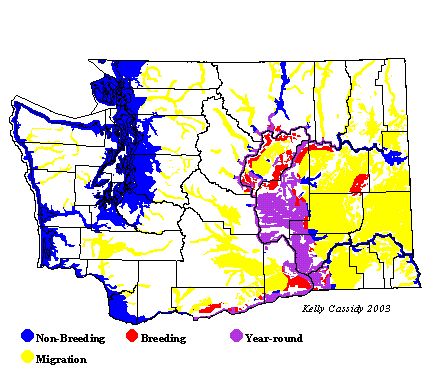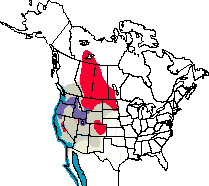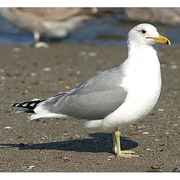California Gull
The Washington representatives of this family can be split into two groups, or subfamilies. The adaptable gulls are the most familiar. Sociable in all seasons, they are mainly coastal, but a number of species also nest inland. Many—but not all—are found around people. Gulls have highly variable foraging techniques and diets. Terns forage in flight, swooping to catch fish or insects. They dive headfirst into the water for fish. Although they are likely to be near water, they spend less time swimming than gulls.
General Description
A medium-sized gull, the California Gull has the typical 'gull-like' appearance'slate-gray back and wings, white head and body, and black wingtips with white spots. The black on the wingtips is more extensive than that of other gulls. The California Gull's eye is dark, and its legs are greenish-yellow. The beak is yellow with red and black marks. Juveniles are, to varying degrees, mottled brown and white, mixed with the adult plumage, with pink legs and beak. It takes four years for California Gulls to mature. This gull is intermediate in size between the smaller Ring-billed Gull and the larger Herring Gull, both of which it resembles.
Habitat
The California Gull is an inland breeding bird but may be seen at any season in marine habitats. It is common far from land in late summer and fall. As a breeder, it can survive in habitats that are too harsh for Herring and Ring-billed Gulls. During the breeding season, California Gulls inhabit lakes, farms, and marshes. They typically nest on gravel islands in large rivers or lakes. In winter, they spend time in nearly every habitat found along the Pacific Coast.
Behavior
California Gulls use a variety of foraging strategies, feeding while walking, wading, swimming, or flying. They are often seen on farms or in fields, following behind the plows and picking up insects uncovered by the machinery. They have also been reported to lie in wait for rodents to be flooded out of their holes when fields are irrigated.
Diet
In Washington, California Gulls feed in agricultural lands, cities, and wetlands near their nesting areas. In agricultural areas in this state, they feed primarily on small rodents. Insects, fish, eggs, and garbage are also part of the diet of this opportunistic feeder.
Nesting
California Gulls begin breeding at the age of four. They are colony nesters, sometimes in mixed colonies with Ring-billed or Herring Gulls, although they don't typically hybridize with either of those species. The colonies are usually large and are often on an island. Nests are located on the ground, and may be quite close together. The birds form monogamous pair bonds for the duration of the breeding season and may re-pair in succeeding seasons. However, they often pair with different birds, even when both members of a former pair are still alive. Both help build the nest, a shallow scrape in the ground lined with weeds, bones, feathers, and other debris. Clutches are usually 2-3 eggs, and nests with more than 3 eggs are attributed to multiple females. Both parents help incubate the eggs for about 3½ weeks. The young leave the nest after a few days, but stay nearby, fed regurgitated food by their parents until they can fly at the age of about 6½ weeks.
Migration Status
Most California Gulls breed in the interior and migrate to the Pacific Coast. Some birds winter inland, and others, especially younger birds, remain in coastal areas throughout the summer.
Conservation Status
Known as the gull that rid the early Mormon settlers in Utah of plagues of grasshoppers, the California Gull is still considered a beneficial species throughout its range, although it has been associated with some crop damage. It is similar in its requirements to the Ring-billed Gull, but its population is smaller and its range more limited. The creation of many dams in eastern Washington has increased nesting habitat there, resulting in significant population increases in the past 50 years. Garbage dumps serve as a source of winter food, helping to sustain the population throughout the year. In 1996 there were 2,000 pairs of California Gulls nesting in Benton County, 4,000 in Walla Walla County, and 1,000 in Klickitat County.
When and Where to Find in Washington
In winter, California Gulls can be found all along the coastline, and also well offshore. It is the only Pacific gull that follows offshore ships in the summer and fall. Small numbers can also be seen on water throughout the Puget Trough in the winter. (It is common from the end of March to early November in Washington.) Breeders can be found in the Columbia Basin and along the Columbia River in Klickitat County. In Grant County, there is a nesting colony by Dry Falls Dam. During summer, small numbers of non-breeders are seen throughout the Puget Trough and along the outer coast, especially at the mouth of the Columbia River. During migration, it is common in offshore, coastal, and western Washington regions. Migrants have also been reported at high elevations throughout the Cascades.
 Abundance
Abundance
| Ecoregion | Jan | Feb | Mar | Apr | May | Jun | Jul | Aug | Sep | Oct | Nov | Dec |
|---|---|---|---|---|---|---|---|---|---|---|---|---|
| Oceanic | R | R | R | R | U | F | C | C | C | C | R | R |
| Pacific Northwest Coast | R | R | R | F | F | U | C | C | C | C | R | R |
| Puget Trough | R | R | R | U | U | F | C | C | C | C | F | R |
| North Cascades | R | R | R | R | R | R | R | R | R | R | R | |
| West Cascades | U | U | F | C | C | C | C | C | C | F | U | U |
| East Cascades | U | U | F | C | C | C | C | C | F | F | U | U |
| Okanogan | F | F | F | C | C | C | C | C | C | C | F | F |
| Canadian Rockies | U | U | R | |||||||||
| Blue Mountains | R | R | R | R | ||||||||
| Columbia Plateau | C | C | C | C | C | C | C | C | C | C | C | C |
Washington Range Map

North American Range Map


Family Members
 Laughing GullLarus atricilla
Laughing GullLarus atricilla Franklin's GullLarus pipixcan
Franklin's GullLarus pipixcan Little GullLarus minutus
Little GullLarus minutus Black-headed GullLarus ridibundus
Black-headed GullLarus ridibundus Bonaparte's GullLarus philadelphia
Bonaparte's GullLarus philadelphia Heermann's GullLarus heermanni
Heermann's GullLarus heermanni Black-tailed GullLarus crassirostris
Black-tailed GullLarus crassirostris Short-billed GullLarus canus
Short-billed GullLarus canus Ring-billed GullLarus delawarensis
Ring-billed GullLarus delawarensis California GullLarus californicus
California GullLarus californicus Herring GullLarus argentatus
Herring GullLarus argentatus Thayer's GullLarus thayeri
Thayer's GullLarus thayeri Iceland GullLarus glaucoides
Iceland GullLarus glaucoides Lesser Black-backed GullLarus fuscus
Lesser Black-backed GullLarus fuscus Slaty-backed GullLarus schistisagus
Slaty-backed GullLarus schistisagus Western GullLarus occidentalis
Western GullLarus occidentalis Glaucous-winged GullLarus glaucescens
Glaucous-winged GullLarus glaucescens Glaucous GullLarus hyperboreus
Glaucous GullLarus hyperboreus Great Black-backed GullLarus marinus
Great Black-backed GullLarus marinus Sabine's GullXema sabini
Sabine's GullXema sabini Black-legged KittiwakeRissa tridactyla
Black-legged KittiwakeRissa tridactyla Red-legged KittiwakeRissa brevirostris
Red-legged KittiwakeRissa brevirostris Ross's GullRhodostethia rosea
Ross's GullRhodostethia rosea Ivory GullPagophila eburnea
Ivory GullPagophila eburnea Least TernSternula antillarum
Least TernSternula antillarum Caspian TernHydroprogne caspia
Caspian TernHydroprogne caspia Black TernChlidonias niger
Black TernChlidonias niger Common TernSterna hirundo
Common TernSterna hirundo Arctic TernSterna paradisaea
Arctic TernSterna paradisaea Forster's TernSterna forsteri
Forster's TernSterna forsteri Elegant TernThalasseus elegans
Elegant TernThalasseus elegans

